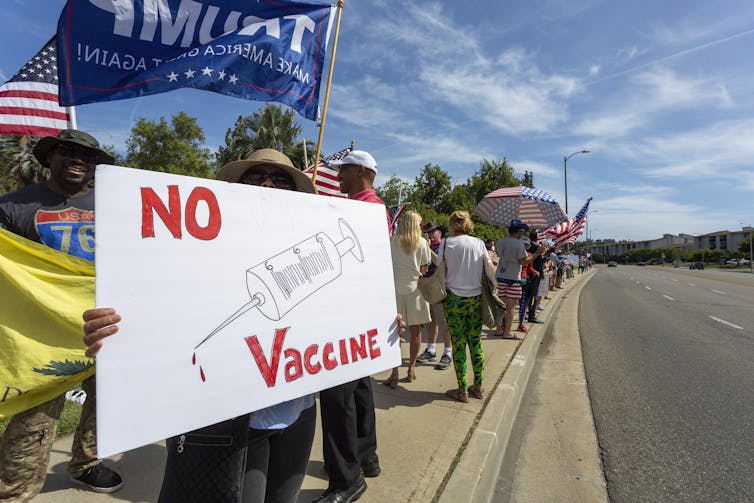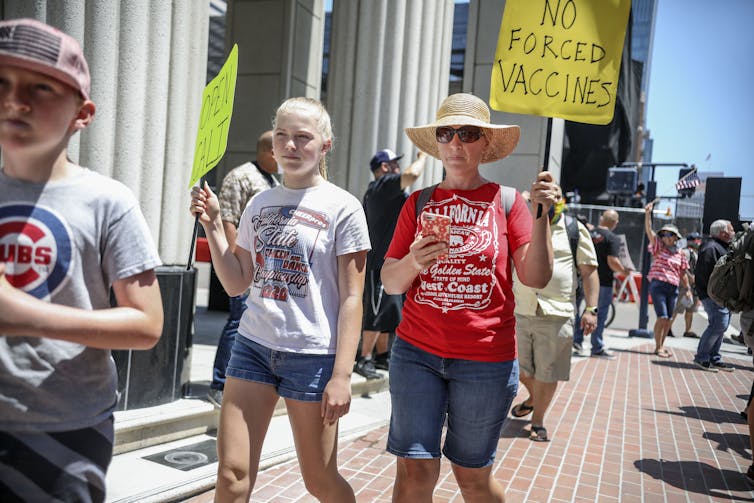Here's how to talk to vaccine skeptics so they might actually hear you
- Written by Erica Weintraub Austin, Professor and Director, Edward R. Murrow Center for Media & Health Promotion Research, Washington State University
An estimated 24,000 to 62,000 people died from the flu[1] in the United States during the 2019-20 flu season. And that was a relatively mild flu season, which typically starts in October and peaks between December and February.
The latest computer model[2] predicts 300,000 deaths from COVID-19 by Dec. 1.
With the advent of flu season, and COVID-19 cases rising, a public health disaster even worse than what we’re now experiencing could occur[3] this fall and winter. Two very dangerous respiratory diseases could be circulating at once.
This will put the general population at risk as well as the millions of people who have pre-existing conditions. Hospitals and health care workers would likely be overwhelmed again.
We are scholars[4] from the Edward R. Murrow Center[5] for Media & Health Promotion Research[6] at Washington State University. As we see it, the only way out of the reopening and reclosing cycles is to convince people to get the flu vaccine in early fall – and then the COVID-19 vaccine when it’s available. Right now, up to 20 COVID-19 vaccine candidates are already in human trials. Chances seem good[7] that at least one will be available for distribution in 2021.
But recent studies suggest that 35%[8] might not want to get a COVID vaccine, and fewer than half[9] received a flu vaccine for the 2019-2020 season.
Getting coverage
To arrest the pandemic’s spread, perhaps 70% to 80% of the population must opt in[10] and get the vaccine. They also need the flu shot to avoid co-infection[11] which complicates diagnosis[12] and treatment.
Achieving herd immunity[13] is a steep climb. We conducted a national online survey, with 1,264 participants, between June 22 and July 18. We found that only 56% of adults said they were likely or extremely likely to get the COVID-19 vaccine. Westerners were most accepting (64%), followed by Midwesterners (58%), with Southerners (53%) and Northeasterners (50%) least likely.
Anti-vaxxers, promoting[14] unlikely scenarios and outright falsehoods about vaccine risks, are not helping.
With all this in mind, we would like to share some myths and truths about how to increase rates of vaccinations.
 A protest against vaccines, with a woman standing on a sidewalk holding a sign. David McNew/Getty Images[15]
A protest against vaccines, with a woman standing on a sidewalk holding a sign. David McNew/Getty Images[15]
Facts don’t convince people
People who support vaccination sometimes believe their own set of myths, which actually may stand in the way of getting people vaccinated. One such myth is that people respond to facts and that vaccine hesitancy can be overcome by facts.
That is not necessarily true. Actually, knowledge alone rarely convinces people to change behavior[16]. Most decisions are informed – or misinformed – by emotions: confidence[17], threat[18], empathy[19] and worry[20] are four of them.
Another myth is that people can easily separate accurate information from the inaccurate. This is not always true, either. With so much misinformation and disinformation out there, people are often overconfident about their ability to discern good from bad. Our research during the H1N1 epidemic showed that overconfidence can lead to faulty conclusions that increase risk[21].
[Expertise in your inbox. Sign up for The Conversation’s newsletter and get expert takes on today’s news, every day.[22]]
Also, it’s not always true that people are motivated to get accurate information to protect themselves and their loved ones. People are often too busy to parse information, especially on complicated subjects. They instead rely on shortcuts, often looking for consistency with their own attitudes[23], social media endorsements[24] and accessibility.
And, to complicate matters, people will sometimes disregard additional fact checking that contradicts their political beliefs[25].
Assuming that people who get the flu vaccine will also get the COVID-19 vaccine is a mistake, too.
In our survey, 52% of respondents said they got a flu or other vaccine in the past year, but only 64% of those who got a vaccine in the past year said they were somewhat or extremely likely to get the COVID-19 vaccine. On the other hand, 47% who did not get a recent vaccine said they were somewhat or extremely likely to get the COVID-19 vaccine.
 Anti-vaccination demonstrators at a re-open rally in San Diego, Calif. Sandy Huffaker/Getty Images[26]
Anti-vaccination demonstrators at a re-open rally in San Diego, Calif. Sandy Huffaker/Getty Images[26]
Ways that do help
Here are five things you can do to encourage your family, friends and neighbors to vaccinate and to seek out reliable information:
-
Help them discern[27] trustworthy news outlets from the rest. Is the outlet clearly identified? Does it have a good reputation? Does it present verifiable evidence to back up claims? It is hard to know whether a site is advancing a political agenda but check the “about” or “sponsors” type of links in the menu on the homepage to gain a bit more information. People should be particularly suspicious[28] if the source makes absolutist claims or evokes stereotypes. An anger-provoking headline on social media might be nothing more than manipulative clickbait, intended to sell a product or profit in some way from a reader’s attention.
-
Make trustworthy news sources accessible and consistent by putting them on your social media feeds. Community service centers are a good one. Partner with opinion leaders people already trust. Our survey respondents viewed local news and local health departments more useful than other outlets, although favorite sources vary with their age and political orientation[29].
-
Provide clear, consistent, relevant reasons to get the vaccines. Don’t forget the power of empathy. Our survey says only 49% thought a COVID-19 vaccine would help them, but 65% believed it would help protect other people. Avoid the temptation to use scare tactics[30] and keep in mind that negatively framed messages sometimes backfire[31].
-
Remember that skepticism about vaccines did not happen overnight or entirely without cause. Research shows that mistrust of news[32] media compromises confidence in vaccination. Many are also skeptical of Big Pharma[33] for promoting drugs of questionable quality. The government must too overcome mistrust based on past questionable tactics[34], including “vaccine squads” targeting African Americans and immigrants. Honesty about past mistakes or current side effects is important. Some information about vaccines, widely disseminated in the past, were later revealed to be wrong[35]. Although the evidence for the efficacy of vaccines is overwhelming, any missteps on this subject breed mistrust. One recent example: Two major studies about COVID-19 treatments were ultimately retracted[36].
-
Let them know that science is the answer, but it requires patience to get it right. Scientific progress is made gradually, with course corrections that are common until they build to consensus[37].
And emphasize the things we are certain of: The pandemic is not going away by itself. Not all news outlets are the same. Both flu and COVID-19 shots are necessary. And vaccines work. Collectively, by turning around those who believe otherwise, we can save lives.
References
- ^ died from the flu (www.cdc.gov)
- ^ latest computer model (www.npr.org)
- ^ a public health disaster even worse than what we’re now experiencing could occur (www.washingtonpost.com)
- ^ We are scholars (murrow.wsu.edu)
- ^ Edward R. Murrow Center (murrowhealth.wsu.edu)
- ^ Media & Health Promotion Research (murrow.wsu.edu)
- ^ Chances seem good (www.washingtonpost.com)
- ^ 35% (news.gallup.com)
- ^ fewer than half (www.cdc.gov)
- ^ must opt in (www.washingtonpost.com)
- ^ avoid co-infection (doi.org)
- ^ complicates diagnosis (wwwnc.cdc.gov)
- ^ herd immunity (www.jhsph.edu)
- ^ promoting (doi.org)
- ^ David McNew/Getty Images (www.gettyimages.com)
- ^ people to change behavior (doi.org)
- ^ confidence (doi.org)
- ^ threat (doi.org)
- ^ empathy (doi.org)
- ^ worry (psycnet.apa.org)
- ^ faulty conclusions that increase risk (doi.org)
- ^ Expertise in your inbox. Sign up for The Conversation’s newsletter and get expert takes on today’s news, every day. (theconversation.com)
- ^ consistency with their own attitudes (doi.org)
- ^ endorsements (doi.org)
- ^ contradicts their political beliefs (doi.org)
- ^ Sandy Huffaker/Getty Images (www.gettyimages.com)
- ^ Help them discern (namle.net)
- ^ suspicious (medium.com)
- ^ their age and political orientation (www.pewresearch.org)
- ^ scare tactics (doi.org)
- ^ backfire (doi.org)
- ^ mistrust of news (doi.org)
- ^ skeptical of Big Pharma (www.nytimes.com)
- ^ questionable tactics (www.goodreads.com)
- ^ to be wrong (www.cdc.gov)
- ^ retracted (www.nytimes.com)
- ^ consensus (doi.org)
Authors: Erica Weintraub Austin, Professor and Director, Edward R. Murrow Center for Media & Health Promotion Research, Washington State University


